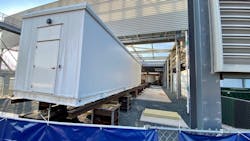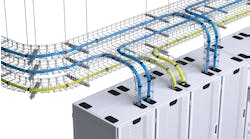Build-to-Suit Approaches Provide Solution for Speed-to-Market and Flexibility
Andrew Schaap, CEO at Aligned explores how adaptive, intelligent and sustainable infrastructure will be able to meet future data demands. This includes build-to-suit data center approaches.
Andrew Schaap, CEO, Aligned Energy
The growth of hyperscale computing has had a major impact on the data center industry. Capacity demands on these organizations continue to exceed projections due to accelerated digital transformation. Just look at how the Microsoft Teams app reached 44 million daily users, adding 12 million in only one week.
And yet, even before enterprises and global populations were thrust into conducting their business, leisure-time activities and studies online, there were markers indicating explosive growth among hyperscalers that predated the current crisis. With rising demand for social networking, gaming and video streaming, Cisco has predicted that by next year, hyperscale data centers will account for 55 percent of total traffic within all data centers, up from 39 percent in 2016. Along with the demand for data analytics and cloud computing, Global Market Insights projects that the hyperscale data center sector will surge at a compound annual growth rate (CAGR) of approximately 19 percent from 2019 to 2025 to reach a market value of $65 billion, up from $20 billion in 2018.
While capacity demand trajectories remain poised for growth, shifting priorities amid the worldwide public health crisis have prompted some organizations to strategically balance the now even greater need for speed-to-market and flexibility, with a commitment to providing the critical infrastructure needed by many of those on the front lines of the pandemic.
Speed Is the New Scale
With hyperscaler demand soaring so precipitously, a data center provider’s ability to ensure speed-to-market, flexibility and scalability has become non-negotiable. Such high-growth, high-capacity customers, including cloud, platform providers, and enterprises with high density computing requirements, are highly dependent upon on-time delivery and scale with minimal exposure to financial risk, among other imperatives. With standardized and repeatable models for expansion, a Build-to-Suit approach often provides the optimal data center solution.
The sudden, historic surge in Internet usage is likely to decrease as global economies recover. However, elevated densities and IT loads will become the new normal. Adaptive, intelligent and sustainable infrastructure will be able to meet these demands.
To deliver these on-demand data center and campus deployments ranging from 10 to north of 180 MW, the data center provider’s stability and ready access to capital cannot be underestimated. Along with a strong capital foundation, a standardized supply chain complete with an auto-replenished pool of available inventory that is ready for immediate deployment and comprised of prefabricated, factory-built and tested power and cooling equipment, further ensures maximum flexibility while minimizing development timeframes.
Future-Proofing That Doesn’t Require Over-Provisioning
At any time, but especially in the present economic environment, undue delays in obtaining adequate data center space can slow, if not obstruct, an organization’s revenue-generating initiatives. Moreover, in attempting to keep pace with business growth or expand into new markets, these companies often find it difficult to accurately predict their future capacity requirements.
To mitigate the risk of lacking the IT capacity needed to facilitate business growth, the default option is for companies to overprovision. However, overprovisioning increases capital and operational expenses, and can negatively impact an organization’s balance sheet.
Here, an advanced supply chain methodology that provides critical, long-lead finished goods in Vendor Managed Inventory (VMI) as well as a modular approach to power and cooling with equipment provided as a standardized kit, enables even faster speed-to-market. New data center builds can be delivered in as few as six to nine months, with customers initiating at one density profile and scaling up in real-time as their business demands, thanks to drop and connect capabilities.
Dynamic Cooling for Evolving Requirements
Any discussion of a data center solution that addresses the requirements of hyperscalers, cloud and platform providers would be remiss if it did not address the need of energy-efficient cooling, as well as the need to accommodate varying densities and adapt to IT load. For this nature of deployments, having an adaptable and intelligent cooling system allows customers to initiate at one density profile and scale up without disruption, all while maintaining industry-leading Power Usage Effectiveness (PUE). Accommodating high, mixed and variable power densities is another critical cooling factor; customers must be able to evolve without reconfiguring infrastructure or stranding capacity.
The sudden, historic surge in Internet usage is likely to decrease as global economies recover. However, elevated densities and IT loads will become the new normal. Adaptive, intelligent and sustainable infrastructure will be able to meet these demands.
Andrew Schaap is CEO at Aligned Energy.





